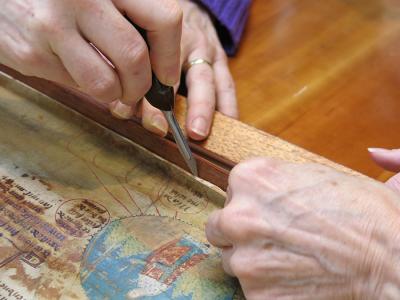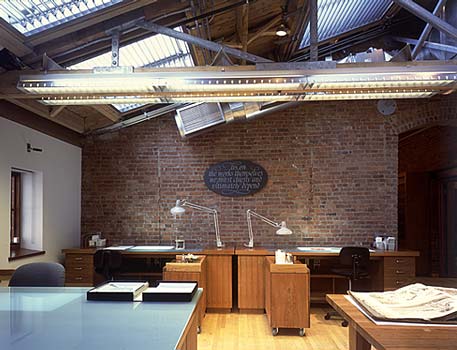This post was created by Reba Fishman Snyder, Paper Conservator and Maria Fredericks, Drue Heinz Book Conservator and Acting Director of the Thaw Conservation Center.
 The Thaw Conservation Center at the Morgan is a world-class laboratory for the conservation of works on paper and parchment—drawings, prints, photographs, illuminated manuscripts, rare books, fine bindings, and literary, historical, and music manuscripts—as well as a place for conservation studies. A critical piece of the Morgan, the Thaw Conservation Center also relies on donations from the public to remain on the cutting edge of scientific research and discovery.
The Thaw Conservation Center at the Morgan is a world-class laboratory for the conservation of works on paper and parchment—drawings, prints, photographs, illuminated manuscripts, rare books, fine bindings, and literary, historical, and music manuscripts—as well as a place for conservation studies. A critical piece of the Morgan, the Thaw Conservation Center also relies on donations from the public to remain on the cutting edge of scientific research and discovery.
Conservators Maria Fredericks and Reba Snyder shared this insider look into a recent conservation project:
In the spring of 2016, an extraordinary medieval object—a genealogical scroll, came into the Thaw Conservation Center because curator Roger Wieck wanted it to become the centerpiece of his 2018 exhibition, Now and Forever: The Art of Medieval Time. It was easy to understand why he wanted the to show this piece—it’s a late 15th-century roll of parchment that is sixty feet long by two feet wide and made of twenty separate pieces of parchment. It is illustrated with small painted roundels, and describes, in great detail (in medieval French) the history of the kings of France, dating all the way back to Adam and Eve. The scroll was acquired by the Morgan in 2007 as part of the Melvin R. Seiden Collection: it is one of only twelve known. It is the most lavishly decorated of the group. It now holds a special place in the extraordinary collection of medieval and renaissance manuscripts at the Morgan.
From the conservator’s point of view the scroll is a complicated three-dimensional object made of parchment (treated animal skins), ink, paint and glue which in the 19th century, was rolled around narrow wooden spindles and attached with nails. We were intrigued and fascinated—none of us had ever seen such a large parchment scroll and we loved the idea of it—fourteen centuries of genealogy going back to creation!
 We needed to understand it to make sure it was safe to show in the exhibition and we had to ask and answer many questions.
We needed to understand it to make sure it was safe to show in the exhibition and we had to ask and answer many questions.
Were the paint and ink well-adhered to the parchment?
How were the different panels of parchment attached to one another? Were they glued or sewn together?
Were these attachments secure enough to withstand handling and exhibition?
Where are the fragile or damaged areas?
Were old repairs safe and stable – were they still doing their job or were they harming the original in some way?
How was the old parchment attached to the wooden spindles and was that safe?
Were the spindles too small for the scroll and if so, should we remove them?
How should we deal with old linings and repairs?
These and more questions were answered by slow and careful examination of the entire scroll under the microscope and detailed discussions between book and paper conservators.
Once we had a good idea of the scroll’s condition—which was remarkably good for its age—we began treatment. Stabilizing the ink and paint, using the microscope to guide the work, was the first step. This ensured that the scroll would be safe to handle during the subsequent conservation procedures.
 The images you see show us prying open the old wooden spindle at the top of the scroll. We then removed the old rusty nails and freed the scroll from the spindle. At that point, we realized that a backing of stiff modern parchment had been added to attach the 15th-century parchment to the wood. We decided to remove that as it was causing stress to the original scroll. We needed three pairs of hands – one to hold the scroll in place and the others to slide a Teflon tool between the old and new parchment, working from each side toward the middle. Once the end of the scroll was free, we rolled it around a much larger diameter core to let it expand and relax. Eventually both the ends of the scroll will be attached to larger spindles for exhibition.
The images you see show us prying open the old wooden spindle at the top of the scroll. We then removed the old rusty nails and freed the scroll from the spindle. At that point, we realized that a backing of stiff modern parchment had been added to attach the 15th-century parchment to the wood. We decided to remove that as it was causing stress to the original scroll. We needed three pairs of hands – one to hold the scroll in place and the others to slide a Teflon tool between the old and new parchment, working from each side toward the middle. Once the end of the scroll was free, we rolled it around a much larger diameter core to let it expand and relax. Eventually both the ends of the scroll will be attached to larger spindles for exhibition.
Conservators tend to be practical problem solvers—which means that we love to think about problems and different ways to solve them. We like to understand how a thing was made—and what has happened to it over its history. We spend a lot of time just looking at an object, getting to know it and its physical properties. We like its quirks—the slightly different colors in the different pieces of parchment, the rust stains (from nails?) that must have happened centuries ago, and the way the parchment moves and stretches. The chance to study every small miniature under the microscope is enchanting. Working on this scroll has given us the opportunity to work together to solve conservation problems and exhibition installation challenges, but mostly it has given us a chance to spend time with a rare and beautiful historic object.
One of the greatest privileges of being a conservator at the Morgan is the opportunity to experience unique works of art in a very intimate way. We learn about the techniques and materials used to create books, manuscripts and drawings dating from the 6th to the 21st centuries, as we assess each item’s condition and develop ways to stabilize inherent fragilities or damage inflicted by time. Our goal is to preserve, or in some cases reveal, each artifact's special character so that exhibition visitors and reading room patrons can share in our fascination and delight. We are always thrilled to see our works on display in the exhibition galleries and shared with the public on our website.
Maria Fredericks, Drue Heinz Book Conservator and Acting Director, Thaw Conservation Center and Reba Fishman Snyder, Paper Conservator
Genealogical and chronicle roll
Northern France, ca. 1470–1475
Melvin R. Seiden Collection, 2007
MS M.1157

